Graham Farish 372-918 N Gauge LMS 10001 BR Green (Small Yellow Panels)
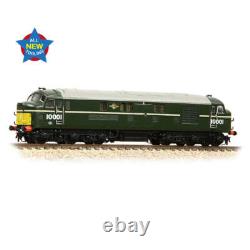
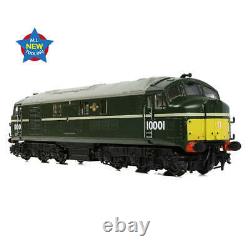
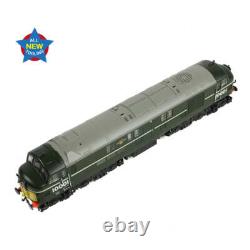
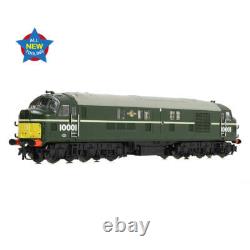
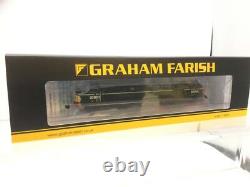

Graham Farish 372-918 N Gauge LMS 10001 BR Green (Small Yellow Panels). PLEASE REVIEW THE PHOTOGRAPHS AS WELL, ACCESSORIES/BOXES ETC WILL BE SHOWN IF THEY ARE INCLUDED.
The LMS'Twins' - Nos. 10000 and 10001 - were the very first mainline diesel locomotives built in the UK and now, this pioneering pair is available in N scale for the first time thanks to Graham Farish. 10001 depicts the second of the'Twins' during its final years in service and makes a perfect addition to any steam/diesel transition fleet.
Carrying the eye-catching BR Green livery with Small Yellow Panels, No. 10001 is modelled at a time when its partner was being withdrawn and 10001 was left to soldier on as the last of a unique pair of prototypes, sustained using parts from its twin, 10000. The Graham Farish model of No. 10001 is a highly detailed masterpiece in miniature, adorned with numerous separately fitted components to accurately capture the appearance of this pioneering machine. The livery application captures the splendour of the prototype, whilst engine room detailing has been replicated through the bodyside windows for the first time. Inside, the proven combination of a coreless motor and twin flywheels, driving both bogies and with all-wheel drive will provide enough power for any prototypical train.The Next18 DCC decoder socket and a pre-fitted speaker make it easy to equip these models for DCC and even add sound, or why not opt for our. Model and enjoy realistic sound effects straight out of the box - whether you're running on analogue or DCC!
Pristine BR Green (Small Yellow Panels) livery. Equipped with a Next18 DCC Decoder Socket - Recommend Decoder 36-567A. DETAIL VARIATIONS SPECIFIC TO THIS MODEL. Six Headcode Lights & Brackets at each end.GRAHAM FARISH LMS 10000 & 10001 SPECIFICATION. Coreless, twin shaft motor with two flywheels providing drive to both bogies. Separate metal bearings fitted to each axle. Gearing arranged for prototypical running speeds and haulage capabilities.
9mm (N gauge) wheels to NEM310 standards with authentic profile and detailing. Removable coupling pockets to NEM355 standards fitted to each bogie. Designed to operate on curves of second radius (263.5mm) or greater. Bogies constructed from multiple components featuring full relief detail, including separately fitted metal sand pipes. Separately applied underframe and roof detail components. Separate lamp irons fitted to each nose. Each model supplied with a full set of model-specific bufferbeam pipework and accessory parts. Directional lighting, switchable on/off at either end on DCC or Analogue control. Cab lighting, switchable on/off (leading end, when uséd on DCC only). Authentic light colours and temperatures selected for each model based on era and application. Speaker installed in all models for optimum sound reproduction. Zimo MS590N18 DCC Sound Decoder fitted to. Sound files produced specifically for the Graham Farish LMS 10000/10001 using recordings from real locomotives. Models operate on DCC and Analogue control as supplied. Authentic liveries applied to all models. Multiple paint applications employed on each model using BR specification colours. Logos, numerals and text added as appropriate using multi-stage tampo printing using authentic typefaces, logos and colours. LMS 10000 & 10001 CLASS HISTORY. 10000 and 10001 were the first mainline diesel locomotives built in Great Britain. A joint venture between the London, Midland & Scottish Railway (LMS) and English Electric, the pair were first conceived in 1946. The body and chassis design was undertaken by the LMS's Chief Mechanical Engineer H. Ivatt, and English Electric provided the engine, electric systems and machinery. 10000 began at Derby Works in 1947 and the locomotive was outshopped in December of that year, days before Nationalisation of Britain's railways.Both locomotives entered traffic in an eye-catching black and silver livery, with large chrome numbers fitted at each end of the bodysides, below the cab windows. The letters LMS were also applied in chrome to No. 10001 did not enter service until mid-1948, with British Railways completing its construction, and so it entered traffic with neither LMS nor BR markings.
The locomotives worked both singularly and as a pair on the Midland Main Line and West Coast Main Line, hauling named expresses and lower key services, and venturing north of the border into Scotland. Interconnecting doors were fitted within the noses of each engine, allowing crew and personnel to move between the two in motion, but this feature was seldom uséd.In 1953 the Twins were sent to the Southern Region, being fitted with an additional pair of marker lights and lamp brackets beforehand which made them compatible with the SR's practice of using headcodes to denote both train types and routes. During a two year period on the Southern Region the Twins worked alongside the Southern's own diesel prototypes before returning to the Midland Region in 1955. As prototypes, changes and modifications were made to the locomotives during the years and this included the fitting of water scoops to allow water for the steam heat boiler to be collected from troughs located between the rails'on the move'. By the late-1950s new, production series diesel locomotives were arriving en-masse and whilst their time in service had been highly educational and helped to shape the BR diesel fleet, the writing was on the wall for this pair on non-standard prototypes. 10000 was officially withdrawn in December 1963, whilst No.
10001 lasted to March 1966, kept going with components salvaged from its Twin. Sadly, neither was saved and both were subsequently scrapped, but their legacy carried on in the Class 40s, 50s and 56s which all uséd versions of the English Electric 16SVT engine and today, works is ongoing to build a replica of No.
We make every effort to describe items accurately, however, nobody is perfect and on the odd occasion we may miss something. If you see anything which is incorrect in this listing, or wish to double check something, please feel free to ask a question. We include pictures of detailing packs, instructions and boxes etc if they are present and included in the price, if they are not in the photo's, you can safely assume they are not there.
If in doubt, please ask and we will confirm. The photographs are also part of the listing, please review them carefully. You can do this by selecting the Request Total button during Checkout (this works only when using the E-Bay Website, it does not appear on the mobile app for phones and tablets). If you receive an item which is not in accordance with the listing, please get in touch BEFORE leaving feedback or opening a return. Resorting to bad feedback without giving us the opportunity to address the issue helps nobody.

